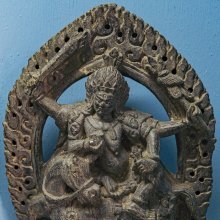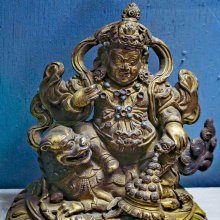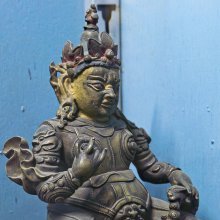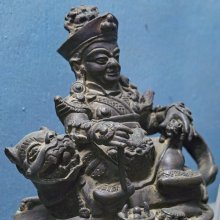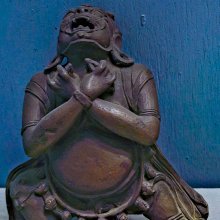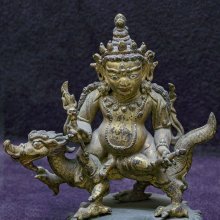Kubera, Kuvera, Kuberā: 52 definitions
Introduction:
Kubera means something in Buddhism, Pali, Hinduism, Sanskrit, Jainism, Prakrit, Marathi. If you want to know the exact meaning, history, etymology or English translation of this term then check out the descriptions on this page. Add your comment or reference to a book if you want to contribute to this summary article.
Images (photo gallery)
(+19 more images available)
In Hinduism
Natyashastra (theatrics and dramaturgy)
Source: archive.org: The mirror of gesture (abhinaya-darpana)Kuvera is one of the Deva-vibhāvana (hands that indicate the forms which accord with the character and actions of Brahmā and other Devas).—Kuvera: left hand–Padma, right hand–Gada.

Natyashastra (नाट्यशास्त्र, nāṭyaśāstra) refers to both the ancient Indian tradition (shastra) of performing arts, (natya—theatrics, drama, dance, music), as well as the name of a Sanskrit work dealing with these subjects. It also teaches the rules for composing Dramatic plays (nataka), construction and performance of Theater, and Poetic works (kavya).
Purana and Itihasa (epic history)
Source: Wisdom Library: Bhagavata PuranaKuvera (कुवेर):—Son of Ilavilā (daughter of Tṛṇabindu) and Viśravā. (see Bhāgavata Purāṇa 9.2.32)
Source: archive.org: Puranic EncyclopediaKubera (कुबेर).—Genealogy. Descended from Viṣṇu thus: Brahmā—Pulastya—Viśravas—Kubera. (See full article at Story of Kubera from the Puranic encyclopaedia by Vettam Mani)
Source: archive.org: Nilamata Purana: a cultural and literary studyKubera (कुबेर) refers to a deity that was once worshipped in ancient Kashmir (Kaśmīra) according to the Nīlamatapurāṇa.—Kubera is the lord of the Yakṣas, he is known also by two other names Vaiśravaṇa and Dhanada, and is regarded as the giver of wealth. Six images of this god erected by various sages etc. have been mentioned. He is a friend of Śiva and the Nāga Nīla.
Source: archive.org: Shiva Purana - English Translation1) Kubera (कुबेर) is a name that Guṇanidhi obtained from Umā, as a result of his severe penance, as mentioned in the Śivapurāṇa 2.1.19. Accordingly, as Umā said to Guṇanidhi:—“[...] dear son, may your pure devotion to Śiva remain for ever. With your left eye burst you will be Ekapiṅga, (having a yellow mark in place of an eye). May all the boons granted to you by the lord fructify. You shall be called Kubera (lit. possessed of ill-shaped body), O son, since you jealously looked at me. After granting these boons to Kubera, lord Maheśvara, in the company of the Goddess Pārvatī, entered his Viśveśvara abode. Thus Kubera attained the friendship of Śiva. Very near his city Alakā was Kailāsa, the abode of Śiva”.
Notes: Kubera is the son of Viśravas by Iḍaviḍā He is the chief of the Yakṣas and a friend of Rudra. He is mythologised as having three legs and eight teeth. Kubera or Kuvera is the God of wealth and the chief of the Yakṣas and Guhyakas. His name Ku-bera or Ku-vera signifies his deformed body having three legs and eight teeth. He is married to Yakṣī, the daughter of the Dānava Mura. As an especial friend of Śiva he is called Śiva-sakhā. His capital Alakā on the Himālaya mountain is mentioned also in the Ṛgveda.
2) Kubera (कुबेर) refers to one of the eight guardians of the quarters, according to the Śivapurāṇa 2.2.22. Accordingly as Śiva said to Sitā:—“[...] the different parts of the mountain Meru seem to be echoing the pleasing sweet sounds of bees etc. which cause the incitement of love of the guardians of the quarters viz. Indra, Kubera, Yama, Varuṇa, Agni, Nirṛti, Marut (Wind) and the Supreme lord (Īśa). Heaven, the abode of the Devas is stationed on the summits of the Meru wherein the cities of the guardians of the quarters are also situated. They are brilliant. Beautiful celestial damsels, Rambhā, Śacī, Menakā and others heighten their glory”.
Source: Cologne Digital Sanskrit Dictionaries: The Purana Index1a) Kubera (कुबेर).—The son of Viśravas (Vaiśrāvaṇa) and Iḍaviḍā. His father initiated him into a great vidyā. Father of three sons—Viśāla and others. Lord of Yakṣas, and brother of Śiva;1 was pleased with Dhruva and blessed him though he killed his followers.2 Presented a golden throne to Pṛthu.3 With his naravāhana attacked Kṛṣṇa taking Pārijāta, but defeated by Satyabhāmā, retreated in fear. Presented to Kṛṣṇa eight treasures and his new city.4 Attended by Guhyakas, he is compared to Yudhiṣṭhira attended by Pāṇḍavas, Kṛṣṇa and sages.5 Lord of Alaka and son of Pulastya and resident of Kailāsa;6 vanquished by Rāvaṇa; wife Ṛddhi and son Nalakūbera.7 Man as his riding animal: followed by Yakṣas and Rākṣasas with respective standards—ulūka and gṛdhra; fought with Jambha and Kujambha and was overwhelmed; fled to Indra helpless; beaten by Tāraka.8 By residing in Benares, attained the status of a Gaṇeśa;9 observed the ādityaśayanavṛata;10 penance at the confluence of the Narmadā and the Kāverī and was blessed by Śiva to be the Lord of Yakṣas;11 icon of;12 defended the chariot of Tripurāri.13
- 1) Bhāgavata-purāṇa IX. 2. 32-33; IV. 1. 37; 11. 33. Vāyu-purāṇa 40. 8; 47. 1; 70. 38. 97. 2.
- 2) Bhāgavata-purāṇa IV. 12. 1-9.
- 3) Ib. 15. 14.
- 4) Ib. X. [65 (V) 45], [66 (V) 4-21]; 50. 56.
- 5) Ib. I. 9. 3.
- 6) Brahmāṇḍa-purāṇa II. 18. 1-2; 35. 94; 36. 218; Matsya-purāṇa 121. 2-3; 137. 32; Vāyu-purāṇa 69. 196.
- 7) Brahmāṇḍa-purāṇa III. 7. 254 and 331; 8. 44; 72. 2; IV. 15. 22; Vāyu-purāṇa 70. 41.
- 8) Matsya-purāṇa 148. 84; 150. 50-108; 153. 179.
- 9) Matsya-purāṇa 180. 62.
- 10) Ib. 47. 30; 55. 32.
- 11) Ib. 189. 4-11; 191. 85.
- 12) Ib. 261. 20-2.
- 13) Ib. 133. 63; 138. 25; 140. 41.
1b) (Dhanada): the guardian of the north;1 presents of, at Umā's marriage;2 in the army of deva's at Tārakāmaya; riding animal of, man;3 Harikeśa got this status at Benares; became annada and kṣetrapāla; Udbhrama and Sambhrama, two Gaṇas in his service.4
- 1) Matsya-purāṇa 67. 15; Viṣṇu-purāṇa V. 36. 12.
- 2) Matsya-purāṇa 154. 489.
- 3) Matsya-purāṇa 174. 17-18.
- 4) Matsya-purāṇa 180. 94-99.
1c) (c)—a Janapada of the Ketumāla.*
- * Vāyu-purāṇa 44. 14.
Kubera (कुबेर) is a name mentioned in the Mahābhārata (cf. XIV.8) and represents one of the many proper names used for people and places. Note: The Mahābhārata (mentioning Kubera) is a Sanskrit epic poem consisting of 100,000 ślokas (metrical verses) and is over 2000 years old.
Kubera is also mentioned in the Mahābhārata (cf. III.87.3) and represents one of the many proper names used for people and places.
Source: Shodhganga: The saurapurana - a critical studyKubera (कुबेर) is the son of Devavarṇinī and Viśravas, according to one account of Vaṃśa (‘genealogical description’) of the 10th century Saurapurāṇa: one of the various Upapurāṇas depicting Śaivism.—Accordingly, [...] Viśravas was born to [Ilavilā and Pulastya]. Viśravas had four wives—Puṣpotkaṭā, Vākā, Kaikasī and Devavarṇinī. From Devavarṇinī was born Kubera.
The story of the origin of Kubera (“lord of the Yakṣas” and “god of wealth”) runs like this:—
“A Brāhmaṇa named Somaśarman in Avanti left home in greed of gain. His wife, deserted by him developed illicit connection with a Śūdra. As a result she was blessed with a son named Duḥsaha. Due to such confusion of caste, the child so born, was looked down upon by his kinsfolk. So he grew way-ward and wicked and finally broke into a temple of Śiva to plunder. But since the wick of the lamp failed during his efforts to find treasure, he had to light no fewer than ten wicks more, thus unconciously paying homage to Śiva. At last one who was sleeping in the temple awoke and stunned the intruder with a blow from a club and the temple guards put him to death. He was born again as an unrighteous and wicked king Sudurmukha of Gāndhāra. But with the store of little merit earned in his former birth he maintained well lighted lamps in diva’s temple. He was ultimately slain by his foes, but by this time all his evil deeds had been exonerated by his piety and he was born next as Kubera, the son of Viśravas. He became the Lord of the Yakṣas”.

The Purana (पुराण, purāṇas) refers to Sanskrit literature preserving ancient India’s vast cultural history, including historical legends, religious ceremonies, various arts and sciences. The eighteen mahapuranas total over 400,000 shlokas (metrical couplets) and date to at least several centuries BCE.
Shaivism (Shaiva philosophy)
Source: Wisdom Library: Kubjikāmata-tantraKuberā (कुबेरा):—Seventh of the eight Mātṛs born from the body of Khecarī, according to the Kubjikāmatatantra. These eight sub-manifestations (mātṛ), including Kuberā, represent the eight directions of the compass (from east to north-east) and are presided over by the Bhairava Saṃvarta and his consort Rudrāṇī. Khecarī is the first of the Eight Mahāmātṛs, residing within the Mātṛcakra (third of the five cakras) and represents the element ether or space.
Source: Shodhganga: Iconographical representations of ŚivaKubera (कुबेर) or Kuberāgama refers to one of upāgamas (supplementary scriptures) of the Vijayāgama which is one of the twenty-eight Siddhāntāgama: a classification of the Śaiva division of Śaivāgamas. The Śaivāgamas represent the wisdom that has come down from lord Śiva, received by Pārvatī and accepted by Viṣṇu. The purpose of revealing upāgamas (e.g., Kubera Āgama) is to explain more elaborately than that of mūlāgamas (e.g., Vijaya-āgama) and to include any new idea if not dealt in mūlāgamas.

Shaiva (शैव, śaiva) or Shaivism (śaivism) represents a tradition of Hinduism worshiping Shiva as the supreme being. Closely related to Shaktism, Shaiva literature includes a range of scriptures, including Tantras, while the root of this tradition may be traced back to the ancient Vedas.
Vastushastra (architecture)
Source: Wisdom Library: Vāstu-śāstraKubera (कुबेर) refers to a type of temple (prāsāda) classified under the group named Vairāja, according to Samarāṅgaṇasūtradhāra chapter 49. The Vairāja group contains twenty-four out of a sixty-four total prāsādas (temples) classified under five prime vimānas (aerial car/palace), which were created by Brahmā for as many gods (including himself). The group represents temples (e.g. Kubera) that are to be square shaped. The prāsādas, or ‘temples’, represent the dwelling place of God and are to be built in towns. The Samarāṅgaṇasūtradhāra is an 11th-century encyclopedia dealing with various topics from the Vāstuśāstra.

Vastushastra (वास्तुशास्त्र, vāstuśāstra) refers to the ancient Indian science (shastra) of architecture (vastu), dealing with topics such architecture, sculpture, town-building, fort building and various other constructions. Vastu also deals with the philosophy of the architectural relation with the cosmic universe.
Vaishnavism (Vaishava dharma)
Source: ISKCON Press: GlossaryKuvera (कुवेर).—One of the important demigods in heaven, and the treasurer of wealth. He benedicted the Pāṇḍavas during their exile in the forest; father of Nalakūvara and Maṇigrīva.
Source: Pure Bhakti: Bhagavad-gita (4th edition)Kuvera (कुवेर) refers to “treasurer of the demigods, god of wealth”. (cf. Glossary page from Śrīmad-Bhagavad-Gītā).
Source: Pure Bhakti: Brhad Bhagavatamrtam1) Kuvera (कुवेर) refers to:—(or Kubera) The treasurer of the demigods and great devotee of Śrī Śiva; father of Nalakūvara and Maṇigrīva. (cf. Glossary page from Śrī Bṛhad-bhāgavatāmṛta).

Vaishnava (वैष्णव, vaiṣṇava) or vaishnavism (vaiṣṇavism) represents a tradition of Hinduism worshipping Vishnu as the supreme Lord. Similar to the Shaktism and Shaivism traditions, Vaishnavism also developed as an individual movement, famous for its exposition of the dashavatara (‘ten avatars of Vishnu’).
Kavya (poetry)
Source: Shodhganga: The Kavyamimamsa of RajasekharaKubera (कुबेर) is the name of an important person (viz., an Ācārya or Kavi) mentioned in Rājaśekhara’s 10th-century Kāvyamīmāṃsā.—In the Kāvyamīmāṃsā of Rājaśekhara says as one of the eighteen disciple of Kāvya-puruṣa. There Rājaśekhara established him as the founder of śabda and alaṃkāra, who created an adhikaraṇa on ubhayālaṃkāra.

Kavya (काव्य, kavya) refers to Sanskrit poetry, a popular ancient Indian tradition of literature. There have been many Sanskrit poets over the ages, hailing from ancient India and beyond. This topic includes mahakavya, or ‘epic poetry’ and natya, or ‘dramatic poetry’.
Shilpashastra (iconography)
Source: Shodhganga: The significance of the mūla-beras (śilpa)Kubera (कुबेर) or Yakṣapatī is one of the Aṣṭadikpālaka (“eight guardians of the directions”), as defined according to texts dealing with śilpa (arts and crafs), known as śilpaśāstras.—In dance, when the right hand of the dancer assumes arāla-hasta and the left hand of the dancer assumes ardhapatāka-hasta, it is vāyu-hasta. If the dancer holds padma-hasta in the left hand and gadā-hasta in the right hand, it is the hasta for Yakṣapatī (Lord of Yakṣas is Kubera). In images, Yakṣapatī is found with a sword in the right hand and a shield in the left hand. In this case, there is dissimilarity in the relevance of the postures of the hands in dancing and iconography.

Shilpashastra (शिल्पशास्त्र, śilpaśāstra) represents the ancient Indian science (shastra) of creative arts (shilpa) such as sculpture, iconography and painting. Closely related to Vastushastra (architecture), they often share the same literature.
Jyotisha (astronomy and astrology)
Source: Wisdom Library: Brihat Samhita by VarahamihiraKubera (कुबेर) is the lord over the new and full moon periods of the fourth six months, according to the Bṛhatsaṃhitā (chapter 5), an encyclopedic Sanskrit work written by Varāhamihira mainly focusing on the science of ancient Indian astronomy astronomy (Jyotiṣa).—Accordingly, “[...] Commencing from the time of creation, ... Indra is the lord over the new and full moon periods of the third six months; Kubera over those of the fourth six months; [...] If Indra should be the lord, the princes will be at war with each other, the crops of Śarat (October and November), will perish and there will be no prosperity in the land. If Kubera should be the lord, rich men will suffer in their wealth but there will be prosperity in the land”.

Jyotisha (ज्योतिष, jyotiṣa or jyotish) refers to ‘astronomy’ or “Vedic astrology” and represents the fifth of the six Vedangas (additional sciences to be studied along with the Vedas). Jyotisha concerns itself with the study and prediction of the movements of celestial bodies, in order to calculate the auspicious time for rituals and ceremonies.
Shaktism (Shakta philosophy)
Source: Google Books: ManthanabhairavatantramKubera (कुबेर) refers to one of the male servants associated with Oḍḍiyāna, one of the sacred seats (pīṭha), according to the Manthānabhairavatantra, a vast sprawling work that belongs to a corpus of Tantric texts concerned with the worship of the goddess Kubjikā.—Nine of the twelve female servants (three in each of the first four seats), are low-caste women who we find, in other contexts, embody the Mothers (mātṛkā). The maids (cellakā) are Yoginīs and the servants their male counterparts [i.e., Kubera]. These replace the spiritual ‘sons’ and ‘daughters’ the goddess generates and the guardians she appoints in the sacred seats listed in the ‘Kubjikāmatatantra’.

Shakta (शाक्त, śākta) or Shaktism (śāktism) represents a tradition of Hinduism where the Goddess (Devi) is revered and worshipped. Shakta literature includes a range of scriptures, including various Agamas and Tantras, although its roots may be traced back to the Vedas.
General definition (in Hinduism)
Source: Wisdom Library: HinduismKubera (कुबेर, “monstrous”):—In Vedic hinduism, he is the regent of the northern direction and represents the God of wealth; he presides over all earthly treasures. He is the chief of the Yakṣās who guard these precious stones and metals. He is also the protector of travelers.
He is depicted as a white dwarf with a large belly. He has three legs which represent the three principle desires:
- putreṣa (‘desire for offspring’)
- vitteṣa (‘desire for wealth and power’)
- and lokaiṣa (‘desire for fame and recognition’).
His wife is Bhadrā and their two sons and daughter are Nalakubera, Maṇigrīva and Mīnākṣī.
In the Viṣṇudharmottara-purāṇa, Kubera is described as the embodiment of both Artha (“wealth, prosperity, glory”) and Arthashastras, the treatises related to it—and his iconography mirrors it. Kubera’s complexion is described as that of lotus leaves. He rides a man—the state personified, adorned in golden clothes and ornaments, symbolizing his wealth. His left eye is yellow. He wears an armour and a necklace down to his large belly.
Source: Apam Napat: Indian MythologyKubera is the king of Yakshas and is the wealthiest person in the universe.
Source: WikiPedia: HinduismKubera (कुबेर): One of the gods of wealth and riches.
In Buddhism
Theravada (major branch of Buddhism)
Source: Pali Kanon: Pali Proper NamesSee Kuvera.
Source: Pali Kanon: Pali Proper NamesKuvera (Kubera) was King of Uttarakuru. His royal residence is Alakamanda and his citadel Visana. (See Vessavana.)
Kuvera’s messengers are:
- Tatola,
- Tattola,
- Tatotala,
- Ojasi,
- Tejasi,
- Tatojasi,
- Sura,
- Raja,
- Arittha
- and Nemi.
His lotus lake is called Dharani. His sons are all called Inda (D.iii.201f). He rules over the northern clime and is lord of the Yakkhas, with a splendid retinue (D.ii.257). He is a follower of the Buddha (SN.v.379).
Kuvera was once a brahmin called Kuvera and owned a sugar cane farm, where he worked seven mills. The produce of one mill he gave in charity, and when his profits increased he gave alms for twenty thousand years. After death he was born as one of the Catummakarajika devas (DA.iii.966; SNA.i.369f).
In literature the name Kuvera signifies the god of wealth, and his city, Alakamanda, is said to embody all prosperity (E.g., Cv.xxxvii.106; xxxix.5; lxxx.5). He had nine treasures (Cv.lxxxvii.31; see Hopkins Epic Mythology, 142f). The Yakkha Punnaka calls himself the minister of Kuvera (J.vi.307, 325). Kuvera is mentioned in a list of those who reached heaven through generosity (J.vi.201).
Theravāda is a major branch of Buddhism having the the Pali canon (tipitaka) as their canonical literature, which includes the vinaya-pitaka (monastic rules), the sutta-pitaka (Buddhist sermons) and the abhidhamma-pitaka (philosophy and psychology).
Tibetan Buddhism (Vajrayana or tantric Buddhism)
Source: Wisdom Library: Tibetan BuddhismKubera (कुबेर) is the name of a deity summoned by the Yamāntaka-mantra and mentioned as attending the teachings in the 6th century Mañjuśrīmūlakalpa: one of the largest Kriyā Tantras devoted to Mañjuśrī (the Bodhisattva of wisdom) representing an encyclopedia of knowledge primarily concerned with ritualistic elements in Buddhism. The teachings in this text originate from Mañjuśrī and were taught to and by Buddha Śākyamuni in the presence of a large audience (including Kubera).
Source: Google Books: VajrayoginiKubera (कुबेर).—Protector deity of the northern cremation ground.—Synonyms for Kubera are Dhanada (Saṃvarodayatantra 17.39), Yakṣādhipa (Guhyasamayasādhanamālā 34) or Vaiśravaṇa (Gyatso). Kubera is the custodian of wealth, and king of the yakṣas. Iconographically in the Śmaśānavidhi, Kubera has a human mount (naravāhana), is yellow, and holds a “mongoose spitting out a jewel” and skull bowl. In the Adbhutaśmaśānālaṃkāra he is yellow, mounted on a nidhi and holds a club (left) and makes the gesture of threatening (right).
Source: archive.org: The Indian Buddhist IconographyKubera (कुबेर) (direction: north) refers to one of the eight Dikpālas, commonly depicted in Buddhist Iconography, and mentioned in the 11th-century Niṣpannayogāvalī of Mahāpaṇḍita Abhayākara.—His Colour is yellow his Vehicle is a Man; he has two arms.
Kubera is described in the Niṣpannayogāvalī (dharmadhātuvāgīśvara-maṇḍala) as follows:—
Source: Wisdomlib Libary: Vajrayogini“In the north, there is Kubera riding on a man. He is of deep yellow colour and holds in his two hands the goad and the gadā (mace)”.
[Kubera is fairly well represented in Tibet].
Kubera (कुबेर) is the name of the protector (dikpati) associated with Gahvara: the northern cremation ground (śmaśāna) according to the Vajravārāhī-sādhana by Umāpatideva as found in te 12th century Guhyasamayasādhanamālā. As a part of this sādhana, the practicioner is to visualize a suitable dwelling place for the goddess inside the circle of protection which takes the form of eight cremation grounds.
These protectors (e.g., Kubera) are variously known as dikpati, dikpāla and lokāpala and can be traced to purāṇic legends where eight protectors are assigned to each direction by Brahmā. According to the Śmaśānavidhi verse 20, these protectors are in union with their wives and have four arms, two of which make the añjali gesture of obeisance, while the second pair usually holds a skull bowl and a tantric weapon. They are variously depicted upon their respective mounts, or sitting at the base of the tree.
Source: academia.edu: The Structure and Meanings of the Heruka MaṇḍalaKubera (कुबेर) refers to one of the eight direction-guardians (dikpāla) of the Guṇacakra, according to the 10th century Ḍākārṇava chapter 15. Accordingly, the guṇacakra refers to one of the four divisions of the sahaja-puṭa (‘innate layer’), situated within the padma (lotus) in the middle of the Herukamaṇḍala. Kubera is associated with the charnel grounds (śmaśāna) named Gahvara; with the tree (vṛkṣa) named Aśvattha; with the serpent king (nāgendra) named Takṣaka and with the cloud king (meghendra) named Ghūrṇita.

Tibetan Buddhism includes schools such as Nyingma, Kadampa, Kagyu and Gelug. Their primary canon of literature is divided in two broad categories: The Kangyur, which consists of Buddha’s words, and the Tengyur, which includes commentaries from various sources. Esotericism and tantra techniques (vajrayāna) are collected indepently.
Mahayana (major branch of Buddhism)
Source: archive.org: Bulletin of the French School of the Far East (volume 5)Kuvera (कुवेर) is the name of a Gandharva appointed as one of the Divine protector deities of Persia, according to chapter 17 of the Candragarbha: the 55th section of the Mahāsaṃnipāta-sūtra, a large compilation of Sūtras (texts) in Mahāyāna Buddhism partly available in Sanskrit, Tibetan and Chinese.—In the Candragarbhasūtra, the Bhagavat invites all classes of Gods and Deities to protect the Law [dharma?] and the faithful in their respective kingdoms of Jambudvīpa [e.g., the Gandharva Keou-p'i-lo (Kuvera) in Persia], resembling the time of the past Buddhas.

Mahayana (महायान, mahāyāna) is a major branch of Buddhism focusing on the path of a Bodhisattva (spiritual aspirants/ enlightened beings). Extant literature is vast and primarely composed in the Sanskrit language. There are many sūtras of which some of the earliest are the various Prajñāpāramitā sūtras.
General definition (in Buddhism)
Source: Wisdom Library: Dharma-samgrahaKubera (कुबेर) refers to the first of the “four world protectors” (caturlokapāla) as defined in the Dharma-saṃgraha (section 7). The Dharma-samgraha (Dharmasangraha) is an extensive glossary of Buddhist technical terms in Sanskrit (e.g., caturlokapāla and Kubera). The work is attributed to Nagarguna who lived around the 2nd century A.D.
Kubera is, besides one of the “four world protectors” (caturlokapāla), also one of the “eight world protectors” (aṣṭalokapāla), one of the “ten world protectors” (daśalokapāla) and one of the “fourteen world protectors” (caturdaśalokapāla).
In Jainism
General definition (in Jainism)
Source: Google Books: Jaina IconographyKubera (कुबेर).—One of the four types of Veśmadevas;—Worship of Kubera in a home is said to bring eternal prosperity.
Source: archive.org: Een Kritische Studie Van Svayambhūdeva’s PaümacariuKūvera (कूवेर) participated in the war between Rāma and Rāvaṇa, on the side of the latter, as mentioned in Svayambhūdeva’s Paumacariu (Padmacarita, Paumacariya or Rāmāyaṇapurāṇa) chapter 57ff. Svayambhū or Svayambhūdeva (8th or 9th century) was a Jain householder who probably lived in Karnataka. His work recounts the popular Rāma story as known from the older work Rāmāyaṇa (written by Vālmīki). Various chapters [mentioning Kūvera] are dedicated to the humongous battle whose armies (known as akṣauhiṇīs) consisted of millions of soldiers, horses and elephants, etc.
Source: archive.org: The Jaina Iconography1) Kubera (कुबेर) is the name of the Yakṣa accompanying Mallinātha: the nineteenth of twenty-four Tīrthaṃkaras or Jinas, commonly depicted in Jaina iconography.—[...] Kubera’s iconographic marks common to both the schools of Jainism are rainbow colour, an elephant as vidiicle, his eight hands and four faces. The Śvetāmbara Kubera Yakṣa holds distinctly, however, a Varada axe, spear, Abhaya, citrus, śakti, club, and rosary. The Digambara image has, instead, the attributes of a shield (phalaka) bow, staff, lotus, sword, axe, noose, Varada-Mudrā.
2) Kuvera (कुवेर) or Vaiśravaṇa, the king of the Yakṣas, who was the treasurer of Śiva and lord of the Alakā is several times referred to in early Hindu literature. His attendants were many and several of them are mentioned in a canonical text of the Jainas thus, Pūrṇabhadra, Maṇibhadra, Śālibhadra, Sumanabhadra, Lakṣarakṣa, Pūrṇarakṣa, Śravaṇa, Sarvayaśas, Sarvakāma, Samṛddha, Amogha, Asmata.
3) Kubera (कुबेर) is also mentioned as one of the Dikpāla or “guardians of the quarters”, a class of deities within Jainism.—Kubera, the protector of the northern regions, has been conceived of by the Śvetāmbara Jainas, as a deity, who rides a man, bears gems and a club. According to the authorities of the same sect, he is the treasurer of Indra, King of Yakṣas, having his control over Kailāsa. He, also, rides the chariot by the name of Puṣpaka. The Digambara view gives not more than the last symbol for the representation of Kubera. Except in one feature namely being the treasurer of Indra instead of Śiva, the Jaina Kubera varies nowise from the Brahmanic Kubera.
Source: archive.org: TrisastisalakapurusacaritraKubera (कुबेर) is the name of the Yakṣa (i.e., Śāsanadevatās—‘messenger-deities’) associated with Malli (Mallī), according to chapter 6.6 [śrī-mallinātha-caritra] of Hemacandra’s 11th century Triṣaṣṭiśalākāpuruṣacaritra: an ancient Sanskrit epic poem narrating the history and legends of sixty-three illustrious persons in Jainism.
Accordingly:—“The Yakṣa Kubera, originating in the congregation, the color of the rainbow, fourfaced, with an elephant for a vehicle, with four right arms, one in boon-granting position, one holding an axe and one a trident, one bestowing fearlessness; with four left arms holding a citron, a spear, a hammer, and a rosary; and Vairoṭyā, originating in the congregation, black-bodied, with a lotus for a seat, adorned with two right arms in boon-granting position and holding a rosary, with her two left arms holding a citron and a spear, became the two messenger-deities of the Arhat, Śrī Malli”..

Jainism is an Indian religion of Dharma whose doctrine revolves around harmlessness (ahimsa) towards every living being. The two major branches (Digambara and Svetambara) of Jainism stimulate self-control (or, shramana, ‘self-reliance’) and spiritual development through a path of peace for the soul to progess to the ultimate goal.
Languages of India and abroad
Pali-English dictionary
Source: BuddhaSasana: Concise Pali-English Dictionarykuvera : (m.) name of the deity who governs the North; the king of Yakkhas.

Pali is the language of the Tipiṭaka, which is the sacred canon of Theravāda Buddhism and contains much of the Buddha’s speech. Closeley related to Sanskrit, both languages are used interchangeably between religions.
Marathi-English dictionary
Source: DDSA: The Molesworth Marathi and English Dictionarykubēra (कुबेर).—m (S) The name of the treasurer of the gods, the Indian Plutus. Hence, appellatively, a rich man, a Crœsus. kubērācēṃ dhana mārkaṇḍēyācēṃ āyuṣya (asāvēṃ) A phrase expressive of the Hindu opinion concerning English law.
Source: DDSA: The Aryabhusan school dictionary, Marathi-Englishkubēra (कुबेर).—m The god of wealth. A rich man, a Crœsus.
Marathi is an Indo-European language having over 70 million native speakers people in (predominantly) Maharashtra India. Marathi, like many other Indo-Aryan languages, evolved from early forms of Prakrit, which itself is a subset of Sanskrit, one of the most ancient languages of the world.
Sanskrit dictionary
Source: DDSA: The practical Sanskrit-English dictionaryKubera (कुबेर).—[kutsitaṃ be (ve) raṃ śarīraṃ yasya saḥ]
1) The god of riches and treasure and the regent of the northern quarter; कुबेरगुप्तां दिशमुष्णरश्मौ गन्तुं प्रवृत्ते समयं विलङ्घ्य (kuberaguptāṃ diśamuṣṇaraśmau gantuṃ pravṛtte samayaṃ vilaṅghya) Kumārasambhava 3.25 (vide Malli. thereon). [Kubera is the son of Viśravas by Iḍāviḍā, and thus the half brother of Rāvaṇa. Besides, being the lord of riches and regent of the north, he is the king of the Yakṣas and Kinnaras, and a friend of Rudra. His abode is Kailāsa. He is represented as being deformed in body-having three legs, only eight teeth, and a yellow mark in place of one eye.]
2) Name of a tree.
Derivable forms: kuberaḥ (कुबेरः).
See also (synonyms): kuvera.
--- OR ---
Kubera (कुबेर).—a.
1) Bad.
2) Bad-limbed.
See also (synonyms): kuvera.
Source: Cologne Digital Sanskrit Dictionaries: Edgerton Buddhist Hybrid Sanskrit Dictionary
Kubera (कुबेर).—as one of the four mahārāja(n), see this.
Source: Cologne Digital Sanskrit Dictionaries: Edgerton Buddhist Hybrid Sanskrit DictionaryKuvera (कुवेर).—as one of the four mahārāja(n), see this.
Source: Cologne Digital Sanskrit Dictionaries: Shabda-Sagara Sanskrit-English DictionaryKubera (कुबेर).—m.
(-raḥ) The deity Kuvera: see kuvera.
Source: Cologne Digital Sanskrit Dictionaries: Shabda-Sagara Sanskrit-English DictionaryKuvera (कुवेर).—mfn.
(-raḥ-rā-raṃ) 1. Deformed, monstrous. 2. Slow, lazy m.
(-raḥ) Kuvera the son of Visravas by Iravira, the chief of the Yakshas, god of wealth and regent of the north. E. ku vile, and vera body, alluding to the deformity of the god. who is represented as having three legs and but eight teeth. 2. The Tun tree: see nandivṛkṣa 3. One of the attendants of a Jaina saint. E. As above, or kuvi to cover, &c. and erac Unadi affix; in this case the word may be read kubera.
Source: Cologne Digital Sanskrit Dictionaries: Benfey Sanskrit-English DictionaryKuvera (कुवेर).—probably for kuvārya, i. e. ku-vṛ + ya, m. The god of wealth, [Mānavadharmaśāstra] 7, 42.
Source: Cologne Digital Sanskrit Dictionaries: Cappeller Sanskrit-English DictionaryKubera (कुबेर).—[masculine] Kubera, the chief of the spirits of darkness, afterwards the god of riches, the regent of the north.
Source: Cologne Digital Sanskrit Dictionaries: Aufrecht Catalogus Catalogorum1) Kubera (कुबेर) as mentioned in Aufrecht’s Catalogus Catalogorum:—father of Arthapati, father of Citrabhānu, father of Bāṇa.
2) Kubera (कुबेर):—the author of the Dattacandrikā: Smṛticandrikā.
Source: Cologne Digital Sanskrit Dictionaries: Monier-Williams Sanskrit-English Dictionary1) Kubera (कुबेर):—m. or in later Sanskṛt kuvera (originally) Name of a chief of the evil beings or spirits or darkness having the Name Vaiśravaṇa, [Atharva-veda viii, 10, 28; Śatapatha-brāhmaṇa] etc.
2) (afterwards) the god of riches and treasure (regent of the northern quarter which is hence called kubera-guptā diś, [Kumāra-sambhava iii, 25]), [Manu-smṛti; Mahābhārata] etc.
3) (he is regarded as the son of Viśravas by Iḍaviḍā [Bhāgavata-purāṇa], the chief of the Yakṣas, and a friend of Rudra [Harivaṃśa 13131]; he is represented as having three legs and only eight teeth; with Jainas he is the attendant of the nineteenth Arhat of the present Avasarpiṇī)
4) Name of a prince of Devarāṣṭra
5) of the great-grandfather of Bāṇa-bhaṭṭa (author of the Kādambarī)
6) of the author of the Datta-candrikā
7) the tree Cedrela Toona
8) mfn. deformed, monstrous, [cf. Lexicographers, esp. such as amarasiṃha, halāyudha, hemacandra, etc.]
9) slow, lazy, [cf. Lexicographers, esp. such as amarasiṃha, halāyudha, hemacandra, etc.]
10) Kuvera (कुवेर):—etc. See kubera.
Source: Cologne Digital Sanskrit Dictionaries: Yates Sanskrit-English Dictionary1) Kubera (कुबेर):—(raḥ) 1. m. The deity, Kuvera.
2) Kuvera (कुवेर):—(raḥ) 1. m. The Indian Plutus. a. Deformed; lazy, slow.
Source: DDSA: Paia-sadda-mahannavo; a comprehensive Prakrit Hindi dictionary (S)Kūbera (कूबेर) in the Sanskrit language is related to the Prakrit words: Kubera, Kuberā.
[Sanskrit to German]
Sanskrit, also spelled संस्कृतम् (saṃskṛtam), is an ancient language of India commonly seen as the grandmother of the Indo-European language family (even English!). Closely allied with Prakrit and Pali, Sanskrit is more exhaustive in both grammar and terms and has the most extensive collection of literature in the world, greatly surpassing its sister-languages Greek and Latin.
Prakrit-English dictionary
Source: DDSA: Paia-sadda-mahannavo; a comprehensive Prakrit Hindi dictionary1) Kubera (कुबेर) in the Prakrit language is related to the Sanskrit word: Kūbera.
2) Kubera (कुबेर) also relates to the Sanskrit word: Kubera.
3) Kuberā (कुबेरा) also relates to the Sanskrit word: Kuberā.
Prakrit is an ancient language closely associated with both Pali and Sanskrit. Jain literature is often composed in this language or sub-dialects, such as the Agamas and their commentaries which are written in Ardhamagadhi and Maharashtri Prakrit. The earliest extant texts can be dated to as early as the 4th century BCE although core portions might be older.
Kannada-English dictionary
Source: Alar: Kannada-English corpusKubēra (ಕುಬೇರ):—
1) [noun] the Regent of Wealth, ruler of north quarter and of lower deities as Yakṣas, Guhyakas, etc.
2) [noun] Viṣṇu, as the immanent consciousness in the heart of wicked people also.
3) [noun] a kind of resin obtained from certain trees, used in perfumes and as incense; frankincense.
4) [noun] (fig.) a very rich man; ಕುಬೇರನ ಮಗ [kuberana maga] kubērana maga = ಕುಬೇರಪುತ್ರ [kuberaputra]; ಕುಬೇರನ ಸಂಪತ್ತು [kuberana sampattu] kubērana sampattu abundant wealth.
--- OR ---
Kuvēra (ಕುವೇರ):—
1) [noun] the Regent of wealth, ruler of north quarter and of lower deities as Yakṣas, Guhyakas, etc.
2) [noun] Viṣṇu, as the immanent consciousness in the heart of wicked people also.
3) [noun] a kind of resin obtained from certain trees, used in perfumes and as incense; frankincense.
4) [noun] (fig.) a very rich man.
Kannada is a Dravidian language (as opposed to the Indo-European language family) mainly spoken in the southwestern region of India.
See also (Relevant definitions)
Starts with (+21): Kubera kanjibilviya, Kubera mishra, Kubera upadhyaya, Kuberaakshi, Kuberabandhava, Kuberabandhu, Kuberabhavana, Kuberacala, Kuberacarita, Kuberachala, Kuberadatta, Kuberadattakatha, Kuberadish, Kuberadri, Kuberagiri, Kuberagupta, Kuberahridaya, Kuberahridya, Kuberak, Kuberaka.
Ends with: Nalakubera.
Full-text (+853): Yaksha, Vaishravana, Dhanada, Ekapinga, Guhyaka, Pushpaka, Ekalinga, Kailasa, Alaka, Yakshendra, Kuveracala, Naravahana, Ilavila, Alakadhipa, Ishasakhi, Punyajaneshvara, Icchavasu, Dhanakeli, Ailavila, Dhaneshvara.
Relevant text
Search found 134 books and stories containing Kubera, Kūbera, Kubēra, Kuberā, Kubērā, Kuvera, Kūvera, Kuverā, Kuvēra; (plurals include: Kuberas, Kūberas, Kubēras, Kuberās, Kubērās, Kuveras, Kūveras, Kuverās, Kuvēras). You can also click to the full overview containing English textual excerpts. Below are direct links for the most relevant articles:
Garga Samhita (English) (by Danavir Goswami)
Verse 5.1.27 < [Chapter 1 - Advice to Kaṃsa]
Verse 6.10.27 < [Chapter 10 - In the Description of the Gomatī River, the Glories of Cakra-tīrtha]
Verse 4.20.22 < [Chapter 20 - The Killing of Pralamba]
Manusmriti with the Commentary of Medhatithi (by Ganganatha Jha)
Verse 7.7 < [Section I - Important Position of the King (rājan)]
Verse 7.3-4 < [Section I - Important Position of the King (rājan)]
Verse 7.42 < [Section IV - Duties of the King]
Cidgaganacandrika (study) (by S. Mahalakshmi)
Verse 70 [Pralayāgni] < [Chapter 2 - Second Vimarśa]
Verse 261 [Śakti shines as Prakāśa-Ānanda] < [Chapter 4 - Fourth Vimarśa]
Brihad Bhagavatamrita (commentary) (by Śrī Śrīmad Bhaktivedānta Nārāyana Gosvāmī Mahārāja)
Verse 2.3.58-59 < [Chapter 3 - Bhajana (loving service)]
Verse 1.2.93-94 < [Chapter 2 - Divya (the celestial plane)]
Verse 1.2.72-75 < [Chapter 2 - Divya (the celestial plane)]
The Shiva Purana (by J. L. Shastri)
Chapter 19 - The friendship of Śiva and Kubera < [Section 2.1 - Rudra-saṃhitā (1): Sṛśṭi-khaṇḍa]
Chapter 20 - Śiva goes to Kailāsa < [Section 2.1 - Rudra-saṃhitā (1): Sṛśṭi-khaṇḍa]
Chapter 22 - The dalliance of Śivā and Śiva on the Himālayas < [Section 2.2 - Rudra-saṃhitā (2): Satī-khaṇḍa]
The gods of northern Buddhism (by Alice Getty)
Related products
